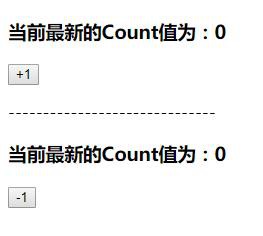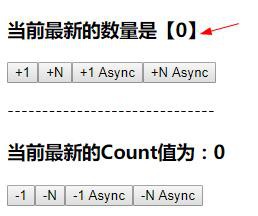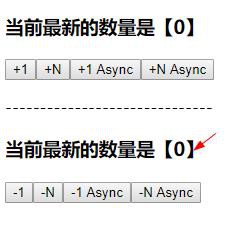VueX安装及使用
JoeYoung 人气:01、安装vuex依赖包
npm install vuex --save
2、导入vuex包
import Vuex from 'vuex' Vue.use(Vuex)
3、创建 store 对象
export default new Vuex.Store({
// state 中存放的就是全局共享的数据
state: {
count: 0
}
})4、将 store 对象挂载到vue实例中
new Vue({
el: '#app',
render: h => h(App),
router,
// 将创建的共享数据对象,挂载到 Vue 实例中
// 所有的组件,就可以直接用 store 中获取全局的数据了
store
})Vuex 是一个专为 Vue.js 应用程序开发的状态管理模式。它采用集中式存储管理应用的所有组件的状态,并以相应的规则保证状态以一种可预测的方式发生变化。
核心模块:State、Mutations、Actions、Module、Getters
在components目录下新建Addition.vue文件:
<template> <div> <h3>当前最新的Count值为:</h3> <button>+1</button> </div> </template>
Subtraction.vue文件:
<template> <div> <h3>当前最新的Count值为:</h3> <button>-1</button> </div> </template>
打开 App.vue 文件,引入俩个组件:
<template>
<div>
<my-addition></my-addition>
<p>------------------------------</p>
<my-subtraction></my-subtraction>
</div>
</template>
<script>
import Addition from './components/Addition'
import Subtraction from './components/Subtraction'
export default {
components: {
'my-addition': Addition,
'my-subtraction': Subtraction
},
data () {
return {}
}
}
</script>(1)、State:
State 提供唯一的公告数据源,所有共享的数据都要统一放到 Store 的 State 中进行存储。我们需要保存的数据就保存在这里,可以在页面通过 this.$store.state来获取我们定义的数据。
// 创建store数据源,提供唯一公共数据
const store = new Vuex.Store({
state: {
count: 0
}
})组件访问 Store 中数据的第一种方式:
this.$store.state.全局数据名称
组件访问 Store 中数据的第二种方式:
// 1.从 vuex 中按需导入 mapState 函数
import { mapState } from 'vuex'通过刚才导入的 mapState 函数,将当前组件需要的全局数据,映射为当前组件的 computed 计算属性:
// 2.将全局数据,映射为当前组件的计算属性
computed: {
...mapState(['count'])
}打开store/index.js文件,定义 count:
import Vue from 'vue'
import Vuex from 'vuex'
Vue.use(Vuex)
export default new Vuex.Store({
state: {
count: 0
},
mutations: {
},
actions: {
},
modules: {
}
})回到Addition.vue文件中,用第一种方式:
<template>
<div>
<h3>当前最新的Count值为:{{$store.state.count}}</h3>
<button @click="handleAdd">+1</button>
</div>
</template>回到 Subtraction.vue文件中,用第二种方式:
<template>
<div>
<h3>当前最新的Count值为:{{count}}</h3>
<button>-1</button>
</div>
</template>
<script>
import { mapState } from 'vuex'
export default {
data () {
return {}
},
// 计算属性
computed: {
...mapState(['count']) // 用...展开运算符把Count展开在资源属性里
}
}
</script>此时效果图:

(2)、Mutations:
Mutations 用于变更 Store 中的数据。只有 mutation里的函数才有权利去修改state中的数据。mutation非常类似于事件:每个 mutation 都有一个字符串的事件类型 (type)和 一个回调函数 (handler)。但是,mutation只允许同步函数,不能写异步的代码。
- ①只能通过 mutation 变更 Store 数据,不可以直接操作 Store 中的数据。
- ②通过这种方式虽然操作起来稍微繁琐一些,但是可以集中监控所有数据的变化。
定义:
// 定义 Mutation
const store = new Vuex.Store({
state: {
count: 0
},
mutations: {
add (state) {
// 变更状态
state.count++
}
}
})第一种触发方式:
// 触发 mutation
methods: {
handleAdd () {
// 触发 mutations 的第一种方式
this.$store.commit('add')
}
}打开store/index.js文件,定义mutations :
mutations: {
add (state) {
state.count++
}
}回到 Addition.vue文件中触发:
<template>
<div>
<h3>当前最新的Count值为:{{$store.state.count}}</h3>
<button @click="handleAdd">+1</button>
</div>
</template>
<script>
export default {
methods: {
handleAdd () {
this.$store.commit('add')
}
}
}
</script>此时点击+1按钮,就可以看到数值变为1。
还可以在触发 mutations 时传递参数:
// 定义 Mutation
const store = new Vuex.Store({
state: {
count: 0
},
mutations: {
addN (state, step) {
// 变更状态
state.count += step
}
}
})第一种触发方式:
// 触发 mutation
methods: {
handleAdd () {
this.$store.commit('addN', 3)
}
}打开store/index.js文件,增加一个addN:
mutations: {
add (state) {
state.count++
},
addN (state, step) {
state.count += step
}
}回到 Addition.vue文件中,增加一个+N的按钮并增加点击事件:
<template>
<div>
<h3>当前最新的Count值为:{{$store.state.count}}</h3>
<button @click="handleAdd">+1</button>
<button @click="handleAdd2">+N</button>
</div>
</template>
<script>
export default {
data () {
return {
num: 2
}
},
methods: {
handleAdd () {
this.$store.commit('add')
},
handleAdd2 () {
// commit 的作用,就是调用某个 mutation 函数
this.$store.commit('addN', this.num)
}
}
}
</script>此时点击+N按钮就会每次增加2。
触发 mutations 的第二种方式:
// 1.从 vuex 中按需导入 mapMutations 函数
import { mapMutations } from 'vuex'通过刚才导入的 mapMutations 函数,将需要的 mutations 函数,映射为当前组件的 methods 方法:
// 2.将指定的 mutations 函数,映射为当前组件的methods 函数:
methods: {
...mapMutations({'add', 'addN'})
}打开store/index.js文件,在mutations增加一个sub:
mutations: {
add (state) {
state.count++
},
addN (state, step) {
state.count += step
},
sub (state) {
state.count--
}
},回到 Subtraction.vue文件中,给-1按钮增加点击事件:
<template>
<div>
<h3>当前最新的Count值为:{{count}}</h3>
<button @click="handleSub">-1</button>
</div>
</template>
<script>
import { mapState, mapMutations } from 'vuex'
export default {
data () {
return {}
},
// 计算属性
computed: {
...mapState(['count']) // 用...展开运算符把Count展开在资源属性里
},
methods: {
...mapMutations(['sub']),
handleSub () {
this.sub()
}
}
}
</script>这时刷新页面,点击-1按钮就会每次-1了。
打开store/index.js文件,增加一个subN:
mutations: {
add (state) {
state.count++
},
addN (state, step) {
state.count += step
},
sub (state) {
state.count--
},
subN (state, step) {
state.count -= step
}
},回到Subtraction.vue文件中,在增加一个-N的按钮,并添加点击事件:
<button @click="handleSub2">-N</button>
<script>
import { mapState, mapMutations } from 'vuex'
export default {
methods: {
...mapMutations(['sub', 'subN']),
handleSub () {
this.sub()
},
handleSub2 () {
this.subN(2)
}
}
}
</script>这时点击-N按钮,每次就-2了。
下面有个需求,就是在点击+1按钮后延迟1秒在显示变化后的数值。
注意:不要在mutations函数中,执行异步操作。所以就需要用到了Action用于处理异步任务。
(3)、Actions:
Action 用于处理异步任务。
如果通过异步操作变更数据,必须通过 Action,但是在 Action 中还是要通过触发 Mutation 的方式间接变更数据。
定义:
// 定义 Action
const store = new Vuex.Store({
// ...省略其他代码
mutations: {
add (state) {
state.count++
}
},
actions: {
addAsync (context) {
setTimeout(() => {
context.commit('add')
}, 1000)
}
}
})第一种方式触发:
// 触发 Action
methods: {
handleAdd () {
// 触发 actions 的第一种方式
this.$store.dispatch('addAsync')
}
}打开store/index.js文件,增加一个 addAsync:
actions: {
addAsync (context) {
setTimeout(() => {
// 在 actions 中,不能直接修改 state 中的数据
// 必须通过 context.commit() 触发某个 mutations 的函数才行
context.commit('add')
}, 1000)
}
}回到 Addition.vue文件中,增加一个+1 Async的按钮并增加点击事件:
<button @click="handleAdd3">+1 Async</button>
<script>
export default {
methods: {
handleAdd () {
this.$store.commit('add')
},
handleAdd2 () {
// commit 的作用,就是调用某个 mutation 函数
this.$store.commit('addN', this.num)
},
handleAdd3 () {
this.$store.dispatch('addAsync')
}
}
}
</script>这时点击+1 Async按钮,可以实现延迟1秒后+1的功能了。
触发 actions 异步任务时携带参数:
定义:
// 定义 Action
const store = new Vuex.Store({
// ...省略其他代码
mutations: {
addN (state, step) {
state.count += step
},
},
actions: {
addNAsync (context, step) {
setTimeout(() => {
context.commit('addN', step)
}, 1000)
}
}
})触发:
// 触发 Action
methods: {
handleAdd () {
// 在调用 dispatch 函数,触发 actions 时携带参数
this.$store.dispatch('addNAsync', 5)
}
}打开 store/index.js 文件,增加一个 addNAsync:
actions: {
addAsync (context) {
setTimeout(() => {
// 在 actions 中,不能直接修改 state 中的数据
// 必须通过 context.commit() 触发某个 mutations 的函数才行
context.commit('add')
}, 1000)
},
addNAsync (context, step) {
setTimeout(() => {
context.commit('addN', step)
}, 1000)
}
}回到 Addition.vue 文件中,增加一个+N Async的按钮并增加点击事件:
<button @click="handleAdd4">+N Async</button>
<script>
export default {
methods: {
handleAdd4 () {
// 在调用 dispatch 函数,触发 actions 时携带参数
this.$store.dispatch('addNAsync', 5)
}
}
}
</script>这时点击+N Async按钮,可以实现延迟1秒后+5的功能。
触发 actions 的第二种方式:
// 1.从 vuex 中按需导入 mapActions 函数
import { mapActions } from 'vuex'通过刚才导入的 mapActions 函数,将需要的 actions 函数,映射为当前组件的 methods 方法:
// 2.将指定的 actions 函数,映射为当前组件的 methods 函数
methods: {
...mapActions(['addAsync', 'addNAsync'])
}打开 store/index.js 文件,在 actions 增加一个 subAsync:
actions: {
addAsync (context) {
setTimeout(() => {
// 在 actions 中,不能直接修改 state 中的数据
// 必须通过 context.commit() 触发某个 mutations 的函数才行
context.commit('add')
}, 1000)
},
addNAsync (context, step) {
setTimeout(() => {
context.commit('addN', step)
}, 1000)
},
subAsync (context) {
setTimeout(() => {
context.commit('sub')
}, 1000)
}
}回到 Subtraction.vue 文件中,在增加一个-1 Async的按钮,并添加点击事件:
<button @click="handleSub3">-1 Async</button>
<script>
import { mapState, mapMutations, mapActions } from 'vuex'
export default {
methods: {
...mapMutations(['sub', 'subN']),
...mapActions(['subAsync']),
handleSub () {
this.sub()
},
handleSub2 () {
this.subN(2)
},
handleSub3 () {
this.subAsync()
}
}
}
</script>还有个更简单的方式:
<button @click="subAsync">-1 Async</button>
<script>
import { mapState, mapMutations, mapActions } from 'vuex'
export default {
methods: {
...mapActions(['subAsync'])
}
}
</script>这样实现的效果是一样的。
下面用同样的思路来实现-N的异步操作:
打开 store/index.js 文件,增加一个 subNAsync:
actions: {
subNAsync (context, step) {
setTimeout(() => {
context.commit('subN', step)
}, 1000)
}
}回到 Subtraction.vue 文件中,在增加一个-N Async的按钮:
<button @click="subNAsync(3)">-N Async</button>
<script>
import { mapState, mapMutations, mapActions } from 'vuex'
export default {
methods: {
...mapActions(['subAsync', 'subNAsync'])
}
}
</script>这时点击-N Async按钮,可以实现延迟1秒后-3的功能。
(4)、Getters:
Getter 用于对 Store 中的数据进行加工处理形成新的数据。不会修改 state 里的源数据,只起到一个包装器的作用,将 state 里的数据变一种形式然后返回出来。
① Getter 可以对 Store 中已有的数据加工处理之后形成新的数据,类似Vue的计算属性。
② Store 中数据发生变化,Getter 包装出来的数据也会跟着变化。
定义:
// 定义 Getter
const store = new Vuex.Store({
state: {
count: 0
},
getters: {
showNum: state => {
return '当前最新的数量是【'+ state.count +'】'
}
}
})使用 getters 的第一种方式:
this.$store.getters.名称
我们可以把文字的内容删除掉,然后用 getters 来替换:
打开 store/index.js 文件,定义getters:
getters: {
showNum (state) {
return '当前最新的数量是【' + state.count + '】'
}
}回到 Addition.vue 文件修改:
<h3>{{$store.getters.showNum}}</h3>此时刷新页面,已经变为了 getters 中的内容,效果图:

使用 getters 的第二种方式:
import { mapGetters } from 'vuex'
computed: {
...mapGetters(['showNum'])
}打开 Subtraction.vue 文件修改:
<h3>{{showNum}}</h3>
<script>
import { mapState, mapMutations, mapActions, mapGetters } from 'vuex'
export default {
// 计算属性
computed: {
...mapState(['count']), // 用...展开运算符把Count展开在资源属性里
...mapGetters(['showNum'])
}
}
</script>效果图:

到此这篇关于VueX安装及使用基础教程的文章就介绍到这了。希望对大家的学习有所帮助,也希望大家多多支持。
加载全部内容